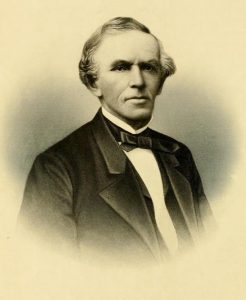
(1800-Feb. 22, 1881). Born in Caldwell, New Jersey, James Ray studied at Columbia University before migrating in 1818 to Lawrenceburg, later Connersville, Indiana, serving as deputy clerk in both towns. He moved to Indianapolis to become clerk of the public land auctions in October 1821.
On April 1, 1822, Ray, the “Whitewater faction” candidate, fought a hotly contested race against of the “Kentucky faction” to become the first (1822-1834). Ray served as county recorder (1829-1834), cashier of the State Bank of Indiana (1834-1855), and cashier and subsequently president of the state bank, which handled the city of Indianapolis’s finances (1857-1865). Ray managed the State of Indiana’s finances during the under Governor . He served in the Internal Revenue Department in Washington, D.C., (1871-1875) before retiring to Indianapolis.
Ray participated in numerous local business ventures. He co-founded, with and Nicholas McCarthy, the , which provided power to the manufacturing businesses in the city. Ray served as a director of the Indiana Mutual Fire Insurance Company (1837-1855), (1853), Indianapolis and Cincinnati Railroad (1854), and the Indiana Mutual Fire Insurance Company.
Ray was active in civic life as well as business. He served as a Sunday school and Indianapolis Tract Society organizer, secretary of the Temperance Society (1828), and member of the American Colonization Society. On Thanksgiving Day, 1835, he co-founded, with James Blake and Calvin Fletcher, the to care for the poor of the city through voluntary contributions and to strengthen family life. Ray served as treasurer from 1835 until he relocated to Washington, D.C., in 1871.
Ray helped establish many important Indianapolis benevolent organizations that remain in the city today. He the Indianapolis Library Society, , and was, at his death, president of the cemetery’s trustees. He served on the Board of National Popular Education, devoted to sending qualified eastern teachers to western schools. He helped obtain the charter for the Presbyterian-sponsored and became a trustee of its successor, the Indianapolis Collegiate Institute.
Ray worked to create an institute for the blind in Indiana. Kentucky had a successful asylum for the blind. In the 1840s he arranged for one of its teachers, William Churchman, to hold an exhibition in Indianapolis. The exhibition convinced legislators to levy a tax to raise funds and the Indiana General Assembly to purchase property for the asylum. Ray served on the building committee for the Indiana Institute for the Education of the Blind, which opened in 1847 as the .

Help improve this entry
Contribute information, offer corrections, suggest images.
You can also recommend new entries related to this topic.